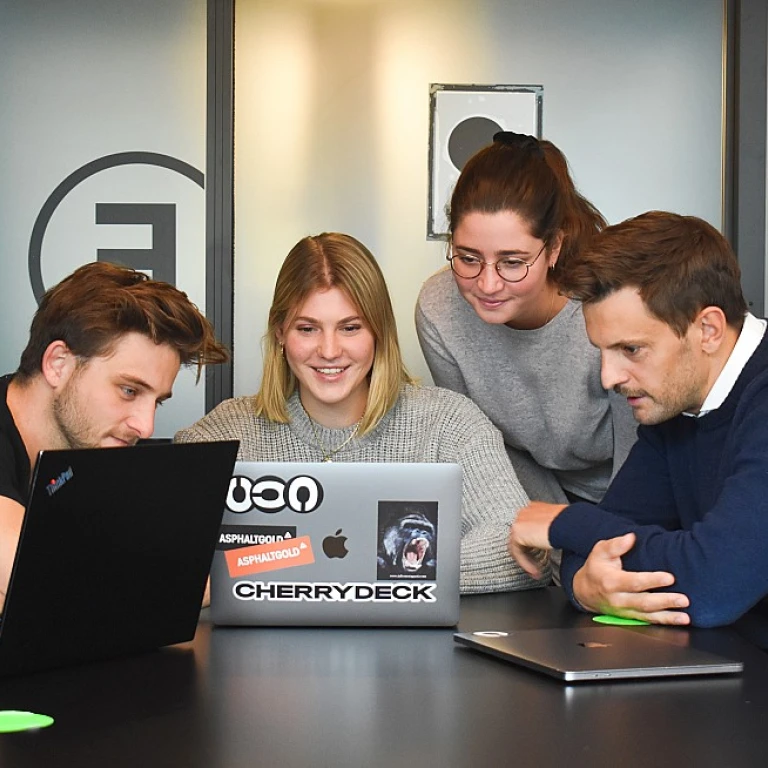Understanding Continuous Learning
Decoding the Essence of Lifelong Learning
Continuous learning goes beyond the traditional classroom walls, having established its importance across various sectors, including academia, corporate environments, and personal development. The approach emphasizes the ongoing acquisition of skills and knowledge, allowing individuals and institutions to adapt swiftly to the ever-changing landscape of ideas and technologies.
The concept is not new; however, the methods and tools have evolved significantly. In today's digital age, platforms such as Moodle and Moodle Rocky have emerged as pivotal components in the learning management ecosystem, transforming how educational content is delivered and managed. These platforms facilitate not just the dissemination of knowledge but also cater to varied demands like installing Moodle in Rocky Linux environments and integrating specific features like PHP FPM and Nginx configurations.
Learning doesn't halt with graduation; rather, it is seen as an infinite loop intertwined with academic calendars, professional milestones, and personal pursuits. Whether it's a student in a community college or a professional at a mountain college seeking new skills, platforms like Moodle have simplified access to a broader spectrum of educational resources.
Particularly in fields demanding constant updates, such as IT, mastering installations such as Moodle Rocky requires understanding elements like server setups, database creation, and managing PHP files. Having a reliable guide to effective support tools can significantly enhance the learning management experience for institutions leveraging these platforms.
The Role of Technology in Continuous Learning
The Transformative Impact of Technology
The advent of technology has significantly altered the landscape of continuous learning. As educational institutions aspire to provide flexible and accessible learning experiences, technology serves as the backbone enabling this evolution. One tool that stands out in this domain is the Learning Management System (LMS), with Moodle being a prominent choice for many academic institutions worldwide.
Moodle, an open-source platform, has become widely favored due to its robust capabilities and flexibility. Running Moodle typically requires a stable server environment. Installation involves multiple components like Linux, PHP, MySQL, or MariaDB for managing the database, and Apache or Nginx as the web server. With these technologies in place, Moodle’s dynamic content and interactive elements serve both students and educators effectively.
For those looking to leverage Moodle, the process often involves multiple steps:
- Server Setup: Ensuring your server environment is compatible with Moodle. Systems such as Rocky Linux provide a stable basis alongside tools like sudo and dnf for managing software packages.
- Database Creation: Utilize commands like `create database` to initiate a database structure suited for Moodle’s needs. Optimizing data directories and permissions using `sudo chown` enhances security and efficiency.
- Software Installation: Deploying Moodle requires precision; commands including `dnf install` become crucial for package management while `sudo systemctl` assists in controlling services.
The beauty of Moodle is its adaptability. Not limited to one type of educational environment, it thrives in varied settings, from large universities to small community colleges. As many institutions might reside in regions with varying levels of technological access, Moodle's capacity to operate on Rocky Linux and other Linux distributions ensures wider reach and inclusivity.
Moreover, Moodle supports real-time interaction and vast customization possibilities, encouraging both student engagement and teacher customization. The platform facilitates an academic calendar creation as well, aiding in the organization of course timelines and events.
Moodle Rocky is poised to redefine continuous learning by supporting these tried and true technological schemas, cementing its place in both rocky mountain colleges and broader academic landscapes. For further insights into how advanced LMS tools are enhancing continuous learning capabilities, you may refer to
advanced LMS tools.
As continuous learning becomes increasingly integral in educational and professional settings, the role of technology, particularly Moodle and its ecosystem, will continue to expand, providing effective, accessible, and inclusive learning solutions.
Introducing Moodle Rocky
Getting Acquainted with Moodle Rocky for Continuous Learning
To harness the full potential of continuous learning, an effective learning management system (LMS) is paramount. Enter Moodle Rocky, an adaptation perfectly designed for environments that heavily rely on technology to foster learning. This system meets the demands of educational institutions and organizations keen on providing a streamlined learning journey.
Setting up Moodle Rocky involves a few crucial steps ensuring a smooth installation and operation. It is optimized to run on Rocky Linux, reflecting its flexibility and compatibility with other open-source systems. The initial step involves installing prerequisites, such as PHP, MySQL, and web servers like Apache or Nginx. Through commands like
sudo dnf install and
sudo chown, you'll prepare your server environment efficiently.
Installation Steps:
- Install the necessary PHP components, ensuring compatibility with your Moodle version. Commands such as
dnf install php fpm are crucial here.
- Set up the MySQL database by creating a dedicated database for Moodle. Use
create database statements judiciously, optimizing the database moodle environment.
- Configure your server by arranging the data directory where Moodle data will reside. Proper permissions via
sudo chown ensure your server operates smoothly.
- Complete the Moodle installation through the web-based interface, specifying paths and directories customized for your academic needs.
Once Moodle Rocky is up and running, the academic calendar and curriculum management become intuitive, allowing educators to focus on content delivery rather than technical queries. Whether you're a student learning from a community college or a prestigious mountain college, Moodle Rocky promises a seamless educational experience.
For anyone embarking on this educational journey, reaching out to existing success stories can inspire confidence. The Moodle community offers robust support, ensuring any challenges faced during setup or operation are swiftly handled. Learn more about the specifics of technological solutions in learning by visiting this
insightful post on marketplace solutions, which further underlines the technological backbone supporting continuous education.
Overcoming Challenges with Moodle Rocky
Conquering Challenges for Continuous Learning with Moodle Rocky
Navigating the challenges of continuous learning can be daunting, but with the right tools and mindset, it's achievable. Moodle Rocky provides a powerful platform to tackle these hurdles head-on.
One of the main challenges is setting up the technical environment. Ensuring compatibility and efficient operation requires specific steps, particularly when dealing with Rocky Linux. Begin by installing necessary components like Apache or Nginx as your web server. Use commands such as
sudo dnf install nginx or
sudo dnf install httpd, depending on your preference. For the database, you can choose between MySQL and MariaDB by running
sudo dnf install mysql-server or
sudo dnf install mariadb-server.
Another hurdle is getting the right version of PHP, especially PHP-FPM for faster CGI processing. The command
sudo dnf install php php-fpm php-mysqlnd will help in setting up the necessary PHP environment. Once your server configurations are in place, proceed to install Moodle by first downloading the Moodle package, unpacking it in the web directory, and adjusting permissions using
sudo chown -R apache:apache /path/to/moodle or
sudo chown -R nginx:nginx /path/to/moodle when using Nginx.
Next, comes the installation process itself. Moodle installation involves heading to the web installer, which guides through the process of creating a Moodle database and setting up the data directory. The command
mysql -u root -p allows you to create a database suitable for Moodle.
Upon successful installation, customization within Moodle Rocky’s learning management system can help overcome challenges academic institutions face. This includes personalizing the academic calendar to fit the college curriculum, especially beneficial for community colleges.
To ensure smooth operation, use
sudo systemctl enable nginx and
sudo systemctl start nginx to manage the server’s service operations effectively. Engage students with effective learning management strategies that Moodle Rocky facilitates.
For more insights into overcoming challenges related to technology in continuous learning environments, feel free to explore further resources and case studies.
Success Stories and Case Studies
Real-Life Applications of Moodle Rocky in Continuous Learning
In exploring the real-world applications of Moodle Rocky, several compelling success stories from educational institutions and organizations demonstrate the transformative power of this platform in continuous learning. These examples highlight how Moodle, when combined with the right technological infrastructure, can effectively address challenges in modern education.
One standout example comes from a community college that adopted Moodle Rocky to streamline its learning management system. The institution aimed to enhance the academic calendar's management, facilitating better coordination and access to resources for students and faculty alike. By leveraging Moodle's robust features and integrating it with their existing server environment powered by Rocky Linux, they achieved a seamless learning experience.
The technical setup involved configuring relevant server components, including nginx and php-fpm, which were essential for optimal performance. Administrators used commands like `sudo dnf install`, `sudo systemctl`, and `sudo chown` to set up the server and manage the necessary permissions. Through careful installation of Moodle and creation of the database using `create database` commands, they ensured a smooth setup process.
Another example can be drawn from an academic institution where Moodle Rocky was instrumental in revolutionizing student engagement. By creating a structured "data directory" and optimizing php settings, the institution's IT team could manage large volumes of academic data efficiently. The use of Linux server and mysql along with Moodle allowed for an effortless data management strategy that contributed significantly to enhancing student learning outcomes.
Furthermore, a mountain college utilized Moodle Rocky to offer specialized courses that supplemented the traditional college curriculum. They utilized Moodle's flexibility to create customized modules and tailored assessments, fitting the unique needs of their Rocky Mountain community's student cohort. The platform's adaptability allowed the college to offer seasonal courses that aligned with local interests and demands.
In these case studies, the practical implementation of Moodle Rocky underscores its potential to address specific educational needs, paving the way for a more dynamic continuous learning environment. These narratives also showcase the significant role of server configurations and installation steps, such as those involving nginx, php, and mysql, which are critical for sustaining an effective Moodle learning environment.
The successful integration and utilization of Moodle Rocky in these contexts affirm its capability to not only meet but exceed the expectations and demands of continuous academic and professional learning environments. By addressing the diverse needs of institutions and organizations, Moodle Rocky is effectively shaping the future of continuous learning.
Future of Continuous Learning with Moodle Rocky
The Path Forward for Continuous Education
As we look to the future, Moodle Rocky continues to show promise in shaping the landscape of continuous learning. By leveraging the capabilities offered by Moodle’s platform along with Rocky Linux, educational institutions and organizations can achieve a robust learning management system tailored for diverse academic needs.
Embracing Technological Advancements
With advancements in technology, integrating tools like Moodle Rocky resolves many challenges faced by continuous learners and educators. Utilizing open-source platforms built on stable operating systems such as Rocky Linux ensures adaptability and resilience in learning environments. Institutions will find that following the appropriate installation steps—such as using commands like `sudo dnf install`, setting up `php fpm`, and configuring `nginx` or `apache`—provides not only a secure foundation but also flexibility. As you create and manage databases with `mysql` or define specifics in the `data directory`, the potential for enhancing academic calendars and curricula becomes evident.
Innovative Integration and Student Support
The Moodle installation process, from command line entries like `sudo systemctl` to detailed configuration within the `moodle directory`, paves the way for significant improvements in student experiences. As educational structures evolve, the ability to seamlessly integrate learning resources encourages ongoing engagement for both traditional students and those in community colleges or online platforms.
Furthermore, creating a database within Moodle or employing commands such as `sudo chown` for proper file permissions exemplifies the technical precision required. As educators invest in such systems, students and faculty alike benefit from a streamlined academic calendar and a user-friendly learning management experience.
Nurturing a Culture of Lifelong Learning
Education leaders from colleges—whether nestled in a rocky mountain environment or urban centers—acknowledge that continuous learning is not optional but necessary. As institutions and organizations adopt Moodle Rocky, they are not just keeping up with technology; they are nurturing a culture where learning never stops.
By facilitating smoother transitions between platforms, offering support through sudo systems, and creating a conducive environment for growth, Moodle Rocky sets a benchmark for others in the realm of educational management systems. As we continue to nurture technology-assisted learning environments, it’s clear that continuous education is thriving because of these innovations.













